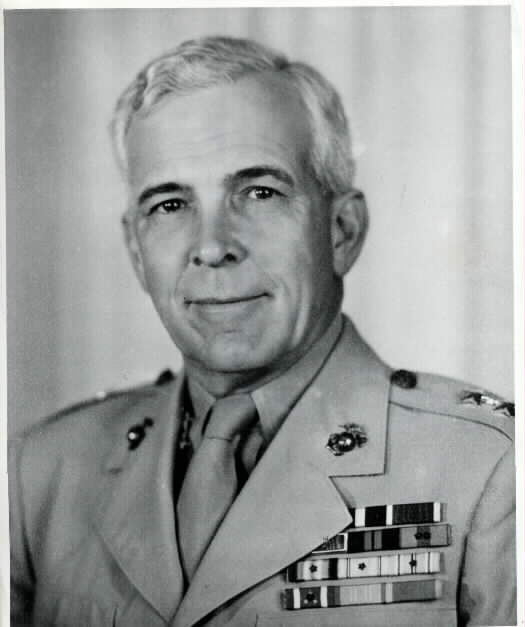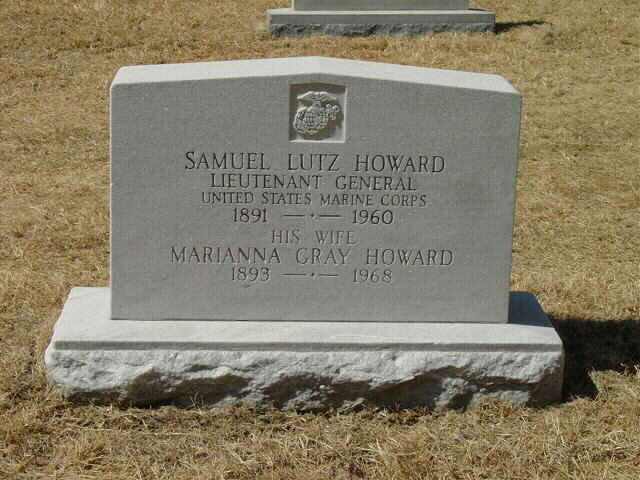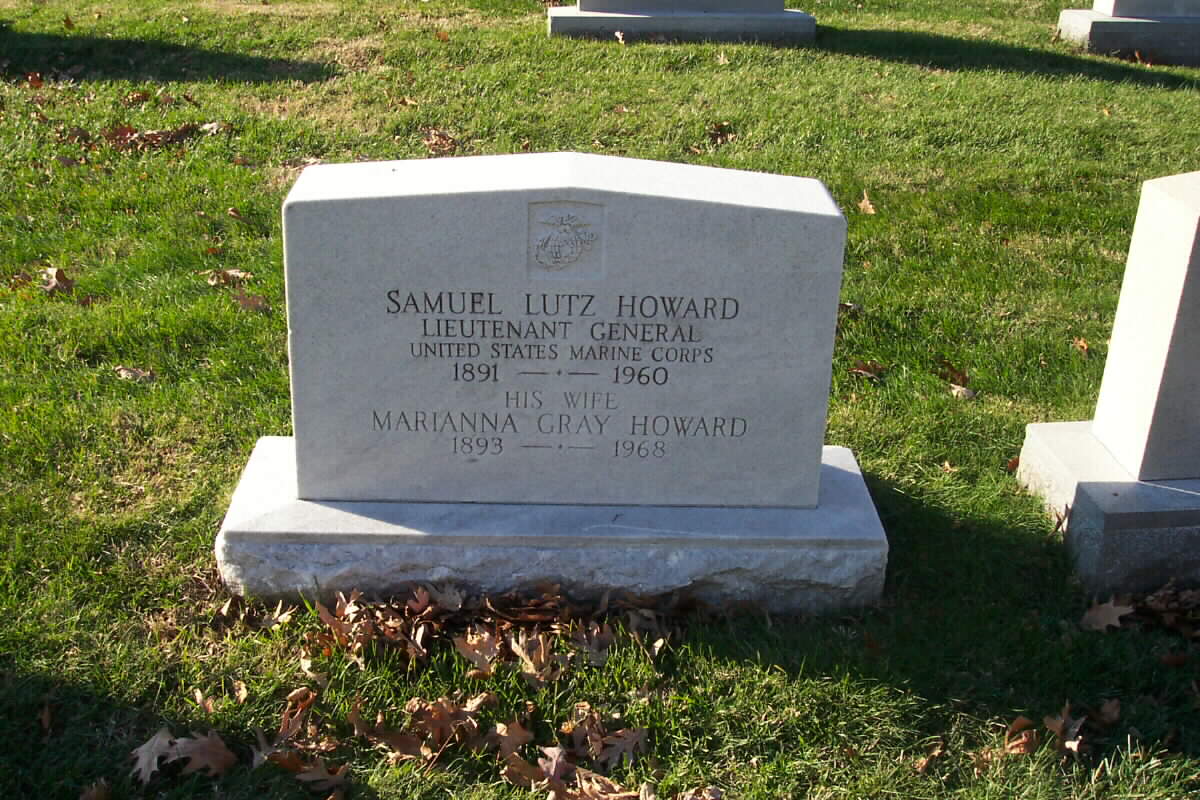Courtesy of the United States Marine Corps
Lieutenant General Samuel L. Howard, who in thirty-eight years of Marine corps service, amassed a record of distinguished and outstanding military achievement, died on October 12, 1960 and was buried at Arlington National Cemetery. In the early stages of World War II, General Howard commanded the Fourth Marine Regiment on Bataan and Corregidor from December 7, 1941 to May 6, 1942. For distinguished service in that bitter encounter, he was awarded the Navy Cross.
His citation reads in part, “…Colonel Howard successfully and efficiently employed his force in the defense of Olongapo until ordered to withdraw. The Regiment was then shifted to Corregidor where it rendered outstandingly courageous service in the defense of the beaches of that island fortress…
“During the prolonged siege, Colonel Howard commanded all beach defenses…Although exposed to many and repeated bombing and strafing attacks, and terrific artillery bombardments, Colonel Howard displayed outstanding qualities of courage, leadership and efficiency under most difficult and hazardous conditions.”
Born on March 8, 1891, at Washington, D.C., General Howard was graduated from the Virginia Military Institute in 1912. He was commissioned a second lieutenant in the Marine Corps on May 11, 1914, at which time he reported for duty at the Marine Officers’ School, Marine Barracks, Norfolk, Virginia. Following completion of his studies he joined the First Brigade Marines at Port au Prince, Haiti, for his first tour of foreign duty.
In December, 1916, he went to sea as a member of the Marine Detachment aboard the USS Wyoming and remained on sea duty for almost three years, assuming command of the Marine Detachment, USS Georgia in 1917, and the Marine Detachment on the USS New Mexico in 1918.
Two years of recruiting duty in Richmond, Virginia, and a year at the Marine Barracks, Washington, D.C., preceded the General’s second tour of foreign duty, this time with the Second Brigade Marines in Santo Domingo.
Returning to the United States in August, 1924, he served at the Marine Corps Base, San Diego, California, with the Fourth Marine Regiment until assigned to the Field Officers’ Course, Marine Corps Schools, Quantico, Virginia, the following year. Upon graduation in May, 1926, he was assigned to duty at Marine Corps Headquarters, Washington, D.C., where he was a member of the War Plans Section, and later a member of the Major General Commandant’s Department.
In June, 1929, General Howard joined the Garde d’Haiti where his duties for the next years included Chief of Police and Department Commander, Port au Prince, Haiti. He was returned to the U.S. and assumed duties with the First Battalion, Seventh Marines, until August, 1934, at which time he was again transferred to Marine Corps Headquarters. The following four years found the General performing the duties of Executive Officer, Division of Operations and Training at that Headquarters.
In June, 1938, he was ordered to the Naval War College, Newport, Rhode Island, as a student in the Senior Course. Following graduation, the General joined the Second Brigade, Fleet Marine Force, as Commanding Officer, Sixth Marine Regiment later becoming Brigade Executive Officer, and finally Division Chief of Staff of the Marine Division.
Eight months prior to Pearl Harbor, General Howard went to China to take command of the Fourth Marines at Shanghai. In late November, the Regiment was withdrawn from China, and arrived in the Philippines on December 2. Five days later, General Howard and the Regiment began the fight that lasted until the fall of Corregidor in May, 1942.
General Howard remained a prisoner of war until liberated in August, 1945. He was returned to the United States, and after several months, was ordered to the Marine Barracks, Parris Island, South Carolina, as Deputy Commanding General.
Returning to China in September, 1946, General Howard assumed command of the First Marine Division (Reinforced) with headquarters in Tientsin. Upon withdrawal of the First Marine Division from China in June, 1947, he was transferred to Pearl Harbor to become Commanding General, Marine Garrison Forces, Pacific, which post to held until September 1, 1948, when he returned to the United States. On September 10, 1948, he was ordered to Headquarters Marine Corps, Washington, D.C., as President of the Naval Examining Board and President of the Marine Corps Reserve Examining Board. He remained at that post until assuming his final duties of Inspector General of the Marine Corps on June 6, 1950. He retired from the Marine Corps on March 31, 1953 and was advanced to the grade of lieutenant general.
In addition to the Navy Cross, his decorations and medals included the Purple Heart, Philippines, 1942; Army Distinguished Unit Badge with Oak Leaf Cluster, Philippines 1941-42; Haitian Campaign Medal, Haiti 1915; Expeditionary Medal with two Bronze Stars, Haiti 1915-16 and 1929-31, Dominican Republic 1922-24; Victory Medal with Atlantic Fleet Clasp, 1918; American Defense Service Medal with Bronze Star; Asiatic-Pacific Campaign Medal with one Bronze Star; Philippine Defense Ribbon with one Bronze Star; World War II Victory Medal; Haitian Medal of Honor and Merit; Haitian Distinguished Service Medal and Diploma; and the Grand Gordon of the Cloud and Banner, China.


Michael Robert Patterson was born in Arlington and is the son of a former officer of the US Army. So it was no wonder that sooner or later his interests drew him to American history and especially to American military history. Many of his articles can be found on renowned portals like the New York Times, Washingtonpost or Wikipedia.
Reviewed by: Michael Howard

